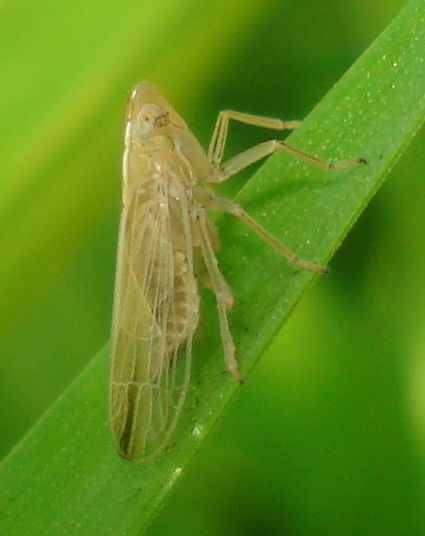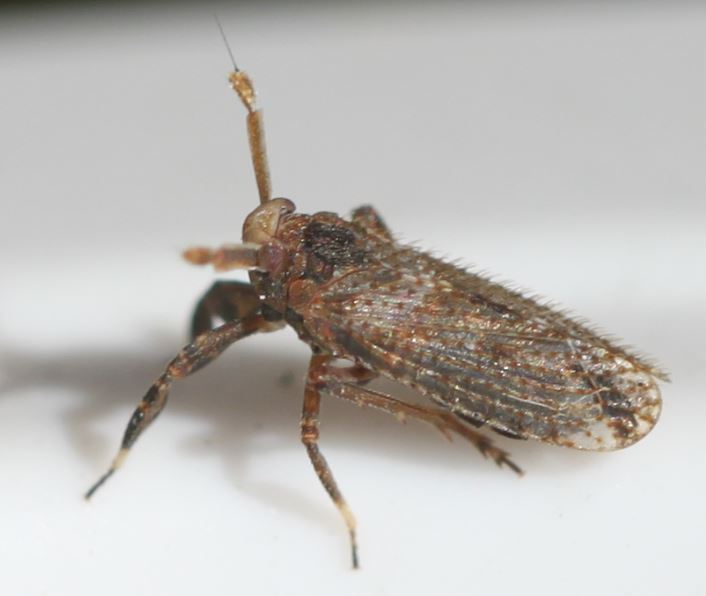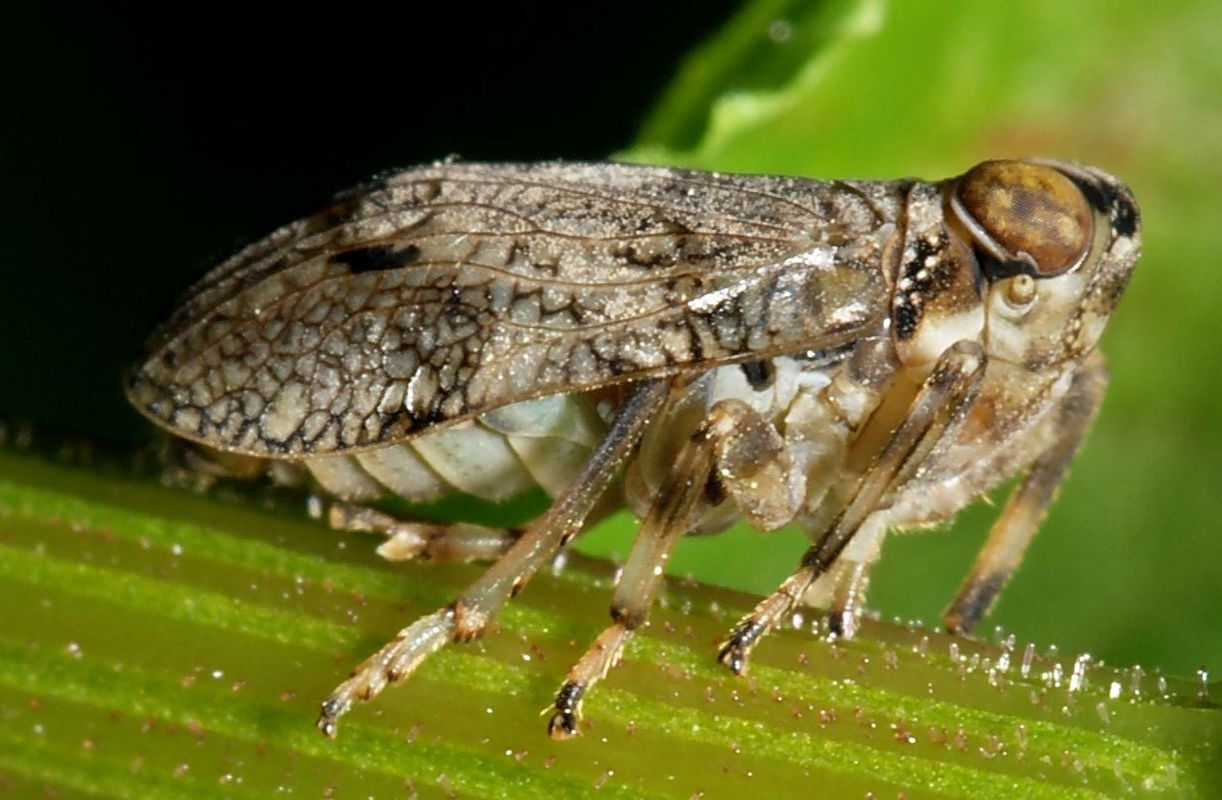- Home
- Garden Wildlife
- Insects
- Hemiptera
- Leafhoppers
Planthoppers
Planthoppers belong in the infra-order Fulgoromorpha, in the sub-order Auchenorrhyncha. They are often leaf-mimics and generally move slowly, although they can hop to avoid predators. The nymphs have an interlocking cog-like mechanism to increase the efficiency of their jumping, which is unique in the natural world1. Like other hemipterans they are plant-suckers.
Species in Britain and Ireland
Although as a group they are common, most are small and probably overlooked in gardens. Most don't have common English names. We have knowledge of two families but few species so far recorded in gardens.
There are 75 species of delphacid planthoppers recorded in Britain. Jennifer Owen found the 5-6mm Stenocranus minutus, and an unidentified species of Javesella. Asiraca clavicornis and Javesella pellucida were found in gardens in Cambrdge.
Stenocranus minutus Javesella pellucida Asiraca clavicornis
Issidae Jeremy Early recorded Issus coleoptratus among his garden bug photos. This distinctive species is fairly common in England, but rarer in Scotland and Wales.

![Planthopper Javesella pellucida Photo: Sanja565658 [CC BY-SA 3.0 (https://creativecommons.org/licenses/by-sa/3.0)]](images/Javesella_pellucida_01.jpg)

Issus coleoptratus Adult 3-4mm long, nymph on human skin on the right
Biology
The planthoppers are poorly studied in comparison with other Auchenorrhyncha. They feed on sap in the phloem tubes of plants, and some are very host species-specific, while others are more catholic in their tastes. Some make use of wax to protect nymphs and eggs. It has recently been shown that they use an abdominal organ2 to communicate through vibrations on the plan surface. Cicadas (also in the Auchenorrhyncha) are much bigger relatives which make extensive use of loud "songs" using abdominal structures. The only British cicada, once found in the New Forest, has not been recorded since the 1990s.
Lifecycle
European species mostly have only one or two generations a year and they overwinter as nymphs or eggs. Around the world examples of species are known with wingless as well as winged forms, linked to rapid reproduction on a favourable host plant.
Role of planthoppers in gardens
Planthoppers are part of the diverse range of plant feeding insects in gardens and do not cause any problems in Britain and Ireland. Some species can be vectors for some plant diseases such as phytoplasmas. and where it occurs (not Britain) the bacterial disease Xylella.
The planthoppers are an excellent example of an overlooked group where a keen citizen-scientist could make significant discoveries about garden species and their ecology in general. They would have to be very keen, because species identification is difficult in this group!
Other sources of information
References:
1. Burrows, M. and G. Sutton. 2013. Interacting Gears Synchronize Propulsive Leg Movements in a Jumping Insect. Science 13 September 2013: Vol. 341 no. 6151 pp. 1254-1256 Available here.
2. Davranoglou L-R, Cicirello A, Taylor GK, Mortimer B (2019) Planthopper bugs use a fast, cyclic elastic recoil mechanism for effective vibrational communication at small body size. PLoS Biol 17(3): e3000155. Available here.
Drafted by Steve Head, reviewed by Andrew Salisbury.

![Planthopper nymph Issus coleoptratus Photo: Bj.schoenmakers [CC0]](images/Issus_coleoptratus_(Planthopper_sp.),_nymph,_Arnhem,_the_Netherlands.jpg)


![Planthopper Javesella pellucida Photo: Sanja565658 [CC BY-SA 3.0 (https://creativecommons.org/licenses/by-sa/3.0)]](images/Javesella_pellucida_01.jpg)
Planthoppers
Planthoppers belong in the infra-order Fulgoromorpha, in the sub-order Auchenorrhyncha. They are often leaf-mimics and generally move slowly, although they can hop to avoid predators. The nymphs have an interlocking cog-like mechanism to increase the efficiency of their jumping, which is unique in the natural world1. Like other hemipterans they are plant-suckers.
Species in Britain and Ireland
Although as a group they are common, most are small and probably overlooked in gardens. Most don't have common English names. We have knowledge of two families but few species so far recorded in gardens.
There are 75 species of delphacid planthoppers recorded in Britain. Jennifer Owen found the 5-6mm Stenocranus minutus, and an unidentified species of Javesella. Asiraca clavicornis and Javesella pellucida were found in gardens in Cambrdge.
![Planthopper nymph Issus coleoptratus Photo: Bj.schoenmakers [CC0]](images/Issus_coleoptratus_(Planthopper_sp.),_nymph,_Arnhem,_the_Netherlands.jpg)

Issus coleoptratus Adult 3-4mm long, nymph on human skin on the right
Biology
The plantshoppers are poorly studied in comparison with other Auchenorrhyncha. They feed on sap in the phloem tubes of plants, and some are very host species-specific, while others are more catholic in their tastes. Some make use of wax to protect nymphs and eggs. It has recently been shown that they use an abdominal organ2 to communicate through vibrations on the plan surface. Cicadas (also in the Auchenorrhyncha) are much bigger relatives which make extensive use of loud "songs" using abdominal structures. The only British cicada, once found in the New Forest, has not been rocorded for many years.
Lifecycle
European species mostly have only one or two generations a year and they overwinter as nymphs or eggs. Around the world examples of species are known with wingless as well as winged forms, linked to rapid reproduction on a favourable host plant.
Role of planthoppers in gardens
Planthoppers are part of the diverse range of plant feeding insects in gardens and do not cause any problems in Britain and Ireland. Some species can be vectors for some plant diseases such as phytoplasmas. and where it occurs (not Britain) the bacterial disease Xylella.
The planthoppers are an excellent example of an overlooked group where a keen citizen-scientist could make significant discoveries about garden species and their ecology in general. They would have to be very keen, because species identification is difficult in this group!
Other sources of information
References:
1. Burrows, M. and G. Sutton. 2013. Interacting Gears Synchronize Propulsive Leg Movements in a Jumping Insect. Science 13 September 2013: Vol. 341 no. 6151 pp. 1254-1256 Available here.
2. Davranoglou L-R, Cicirello A, Taylor GK, Mortimer B (2019) Planthopper bugs use a fast, cyclic elastic recoil mechanism for effective vibrational communication at small body size. PLoS Biol 17(3): e3000155. Available here.
Drafted by Steve Head, reviewd by Andrew Salisbury
Stenocranus minutus Javesella pellucida Asiraca clavicornis
Issidae Jeremy Early recorded Issus coleoptratus among his garden bug photos. This distinctive species is fairly common in England, but rarer in Scotland and Wales.












